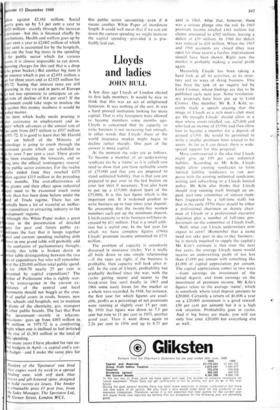Lloyds and ladies
JOHN BULL
A few days ago Lloyds of London elected its first lady members. It would be nice to think that this was an act of enlightened feminism. It was nothing of the sort. It was a hard pressed institution looking for more capital. That is why foreigners were allowed to become members some months ago. Lloyds is concerned that its capacity to write business is not increasing fast enough, in other words that Lloyds' share of the world insurance market might begin to decline rather sharply. One part of the answer is more capital.
At the moment the rules are as follows. To become a member of an underwriting syndicate (to be a 'name' as it is called) you need to show that you have realisable assets of £75,000 and that you are prepared to stand unlimited liability, that is that you are prepared to pay over to the last button on your last shirt if necessary. You also have to put up a £15,000 deposit (part of the £75,000). It is this last figure which is the important one. It is reckoned prudent to write business up to four times your deposit. So presuming that the twenty-five women members each put up the minimum deposit, Lloyds capacity to write business will have in- creased by £14 million. That is a small addi- tion but a useful one. In the last year for which we have complete figures (1966) Lloyds' premium income amounted to £531 million.
The problem of capacity is ceaselessly discussed in insurance circles. Yet it really all boils down to one simple relationship —if the rates are right, if the business is profitable, then capacity will look after it- self. In the case of Lloyds. profitability has gradually declined since the war, with the cycles getting nearer and nearer to the break-even line until finally in 1965 and 1966 some nasty losses for the market as a whole were recorded. In 1948. for instance, the first year for which figures are avail- able, profits as a percentage of net premiums were running at slightly over 15 per cent. By 1950 that figure was down to 7.3 per cent but rose to 11 per cent in 1953, another good year. Then it went down again to 2.26 per cent in 1956 and up to 8.73 per cent in 1960. After that, however, there was a serious plunge into the red. in 1965 premium income totalled £461 million but claims amounted to £502 million, leaving a deficit of £39 million. In 1966 the deficit was reduced to £18 million. When the 1967 and 1968 accounts are closed (they stay open for three years) a further improvement should have been shown. Right now the market is probably making a useful profit again.
Meanwhile Lloyds has been taking a hard look at all its activities, at its struc- ture and its ways of doing business. This has been the task of an inquiry led by Lord Cromer, whose findings are due to be published early next year. Some revolution- ary proposals have been put up to Lord Cromer. One member, Mr R. J. Kiln, re- cently made a speech arguing that the image of Lloyds as a rich man's club must go. He thought Lloyds' should allow in a man whose assets totalled, say, £25,000 and who had an income of £5,000, and then allow him to become a member for a deposit of around £5,000. He would be permitted to write a smaller premium limit related to his assets. As far as I can detect, there is wide- spread support for this proposal.
More controversial is the idea that Lloyds might give up 100 per cent unlimited liability. According to Mr Kiln, Lloyds might allow existing syndicates to form limited liability syndicates to run pari passe with the existing unlimited syndicates, writing and subscribing to a Lloyds limited policy. Mr Kiln also thinks that Lloyds should stop running itself through an un- paid, part-time committee of sixteen mem- bers (supported by a full-time staff) but that in the early 1970s there should be either a professional chairman or deputy chair- man of Lloyds or a professional executive chairman plus a number of full-time pro- fessionals on the committee of Lloyds itself.
Well, what can Lloyds underwriters now expect to earn? (Remember that a name need not take part in day-to-day business: he is merely required to supply the capital.) Mr Kiln's estimate is that over the next five years. the average Lloyds name would receive an underwriting profit of not less than £5.000 per annum with something like £1,000 of capital appreciation per annum. The capital appreciation comes in two ways —from earnings on investment of the initial deposit, and from earnings on the investment of premium income. Mr Kiln's figures relate to the average 'name', which is somebody whose total deposit amounts to £20,000. Certainly a return of £6,000 a year on a £20,000 investment is a good reward. (30 per cent per annum) but it is a high risk situation. Profitability goes in cycles. And if big losses are made, you will not only lose your £20,000 but everything else as well.














































 Previous page
Previous page